I never knew how amazing pickled peaches could taste until I tried Joyce Goldstein's pickled peach recipe from her practical Jam Session: A Fruit-Preserving Handbook. I believe these are also called Southern pickled peaches. The pickling juice is divine. You can drink it straight. It tastes like slightly tart, sweet citrusy syrup. The aroma of cinnamon and cloves is captivating. The color is dark amber, it's gorgeous. I started with two jars as I wasn't sure if we'd like these peaches, but now I am sold and will add more to enjoy them all year.
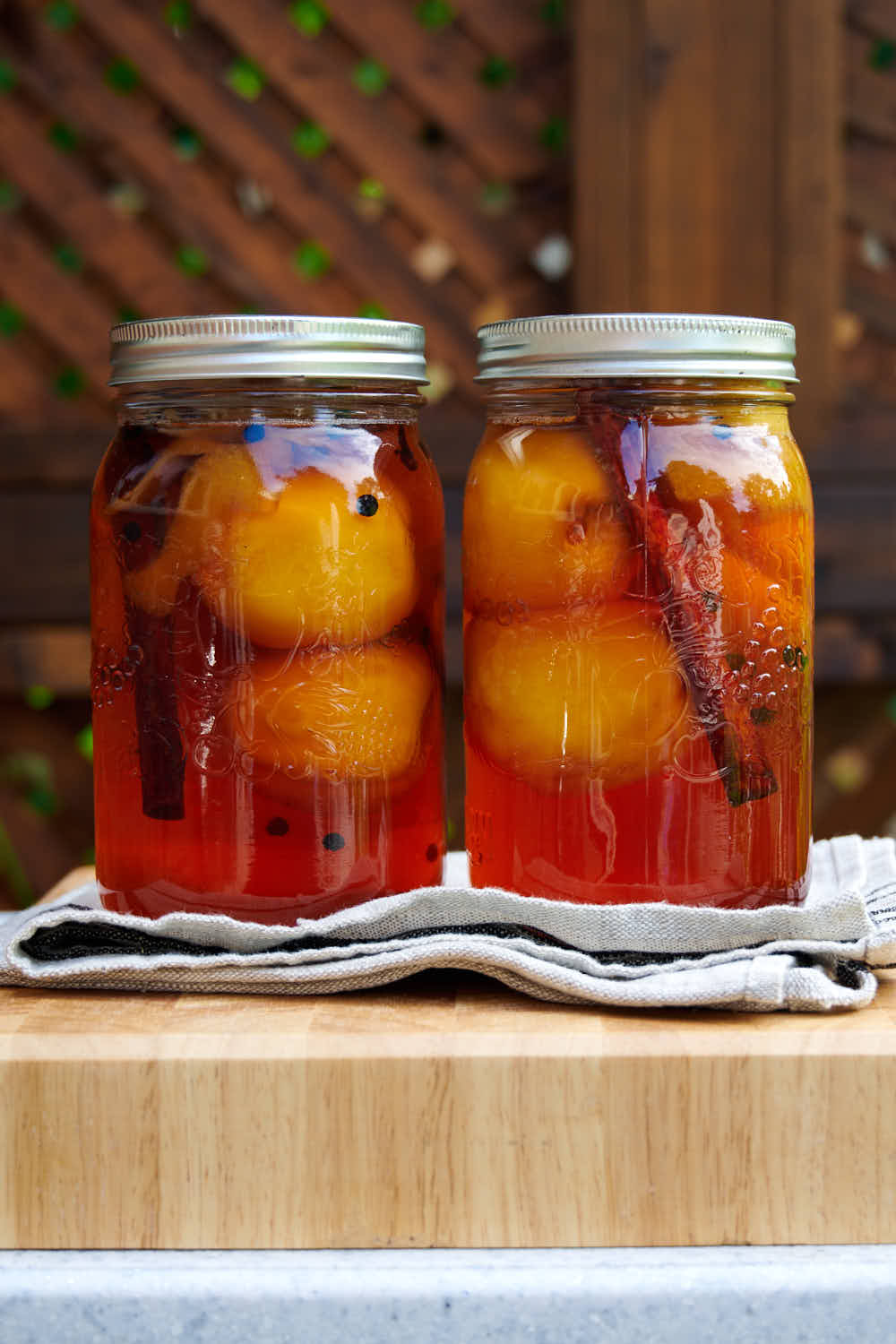
It's peach time. We bought a whole bunch of delicious peaches at a farmers' market, and I had an opportunity to try new recipes. Joyce says she used to serve these pickled peaches with fried chicken at their restaurant on the Fourth of July. Her family loved them so much that Joyce always had a few jars in her pantry. I'll be doing the same. I can't wait to try these peaches with ice cream too.
Some notes about the recipe
The original recipe in the book specifies a 3-4 quart yield, which turned out to be quite off for me. I did not have enough pickling brine for even two jars, so I made some adjustments.
Small to medium peaches work best as they fill the jars better. I was able to fit 4 medium peaches in each quart jar. I would estimate two peaches per quart jar if I used very large peaches unless I cut them in halves. Pint jars can work, too, but you are looking at only about two peaches per jar.
Keep in mind that after processing, peaches will shrink, so you want to fill jars as tightly as possible. You can't do that with very big peaches.
This recipe is quite versatile. You can stop before canning to make what is known as quick pickled peaches that will store well in a refrigerator.
Alternatively, you can proceed with canning them and make canned pickled peaches that will store for up to a year or longer in a cool, dry place. Refrigerator pickled peaches will store well for up to 3 months or even longer. I haven't tested this, but my fermented pickles stayed fresh for over 6 months in the fridge.
Making pickled peaches
The process is very simple. We start with boiling a pot of water. Peaches are blanched in hot water for 1-2 minutes, then dunked in an ice water bath. This loosens skins that slip right off.
Next, we prepare the brine, which consists of a few very simple ingredients: apple cider vinegar, water, sugar, cinnamon, cloves, lemon zest, and peppercorns.
Peeled peaches are poached in a boiling brine for a couple of minutes. Next, we fill sterilized jars with poached pickles. If your peaches are too large, you can cut them in halves. Once the jars are filled with peaches, we add hot pickling brine, leaving 1/2-inch headspace.
The next step will depend on whether you want to make quick refrigerator pickled peaches or canned pickled peaches.
Making refrigerator pickled peaches
After filling jars with poached peaches and hot pickling brine, cover the jars with tight lids and let them cool to room temperature. Next, transfer to the refrigerator and store for up to 3 months, maybe even longer. No additional steps are required.
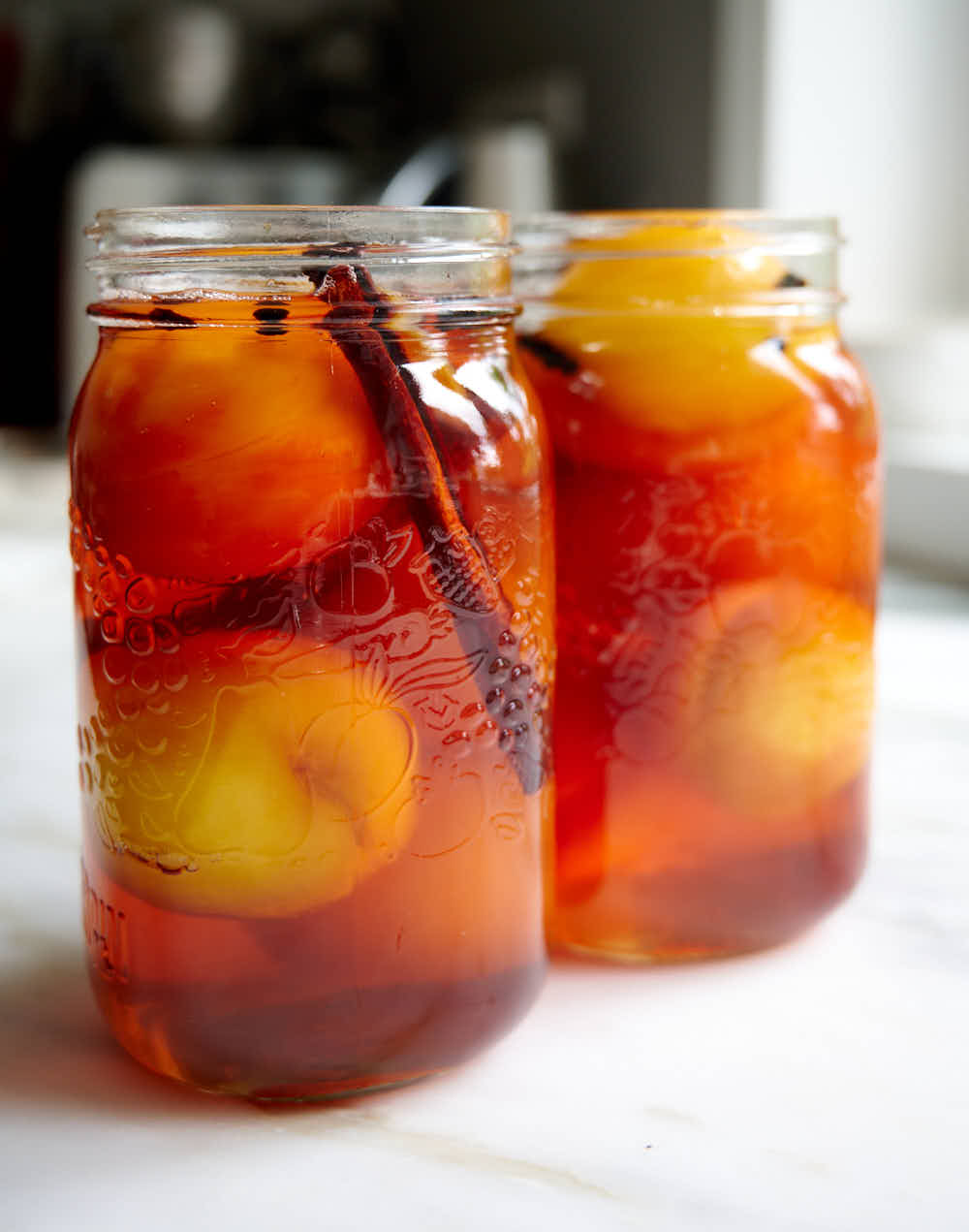
Making canned pickled peaches
If you want to extend the storage life of your pickled peaches, you will need to can them.
Canning pickled peaches can be done in a hot water canner. You do not need a pressure canner.
Bring water to boil in a large pot, ensuring enough water to cover the jars at least 2 inches above the lids. Process quart jars for 25 minutes at 0-1,000 feet above sea level. 30 minutes at 1,001-3,000 feet, 35 minutes at 3,001 - 6,000 feet, and 40 minutes at above 6,000 feet. The book recommends 20 minutes for pints and quarts, but I adjusted based on USDA's fruit canning guide.
If canning peaches in pint jars, reduce the above specified times by 5 minutes. Refer to USDA canning guide for dial-gauge and weighted-gauge canning specifications.
Remove jars from the canner and let cool to room temperature. Store in a cool, dry place for up to a year or even longer. Canned fruit will slowly begin to lose its freshness after a year of storage but will still be good and safe to eat well past that.
Variations
Instead of sugar, use honey to make pickled peaches in honey pickling brine. Use about 2/3 - 3/4 cup of honey for every cup of sugar. This is because honey is sweeter than sugar. Leave the rest of the ingredients as is.
Enjoy!
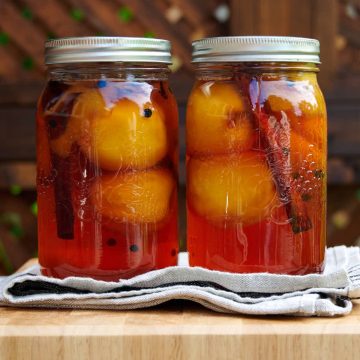
Ingredients
- 8 firm, ripe medium peaches
- 2 cups apple cider vinegar
- 2 cups water
- 4 cups granulated sugar
- 2 cinnamon sticks
- 12 whole cloves
- 4 strips lemon zest
- 1 teaspoon black peppercorns slightly bruised (optional)
Instructions
- If you are canning peaches, sterilize 2 one-quart jars and lids in boiling water and set them aside on a clean surface. Do not discard the water as you will use it for canning. Turn off the heat. If making refrigerator pickled peaches, the jars and the lids need to be clean but don't need to be sterilized.
- Bring a large pot of water to a boil. Prepare a bowl of ice water.
- Blanch the peaches in the boiling water for 1-2 minutes, then dunk them in the ice water to cool down.
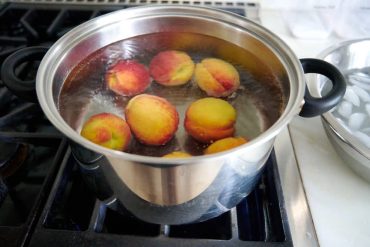
- Next, peel the peaches. The peels should come right off. If not, use a peeler with a serrated swivel blade to remove them.
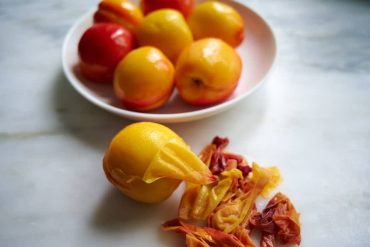
- Cut the peaches in half if they are too large to fit in the jar.
- Combine the vinegar, water, sugar, cinnamon, cloves, lemon zest, and peppercorns in a non-reactive saucepan. Bring the mixture to a boil over medium-high heat, stirring until the sugar dissolves. Decrease the heat to low and simmer for 10 minutes.
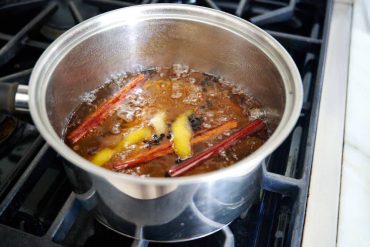
- Poach 3 or 4 peaches at a time in the syrup for 2 minutes. Using a slotted spoon, transfer the peaches to the jars.
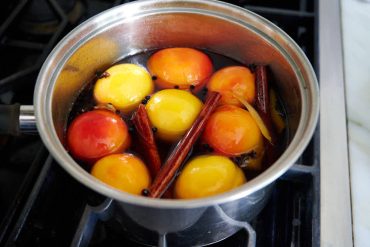
- Fill the jars with the hot syrup, leaving 1/2-inch headspace. Distribute the cinnamon sticks, cloves, and lemon peels among the jars.
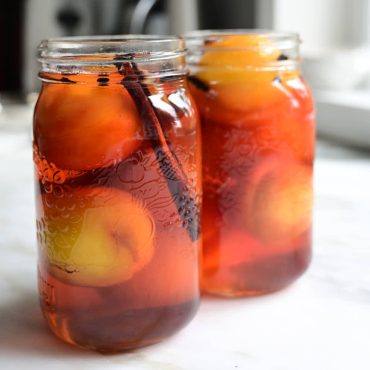
Refrigerator Pickled Peaches
- Cover the jars with tight lids and let them cool to room temperature.
- Transfer the jars to the refrigerator and store for up to 3 months, possibly longer.
Canned Pickled Peaches
- Wipe the rims with slightly damp paper towels or a clean kitchen towel, set the lids on the mouths of the jars, and screw on the rings finger-tight.
- Using a jar lifter, gently lower the jars into the pot with the hot (not boiling) water. Make sure that the water covers the jars an inch above the lids. Bring the water to a boil and process the jars for 30 minutes at 1,001-3,000 feet above sea level, 35 minutes at 3,001 - 6,000 feet, and 40 minutes above 6,000 feet. Turn off the heat and leave the jars in the water for 1-2 minutes.
- Using a jar lifter, carefully transfer the jars from the pot to a baking sheet lined with paper towels and let them at room temperature for at least 6 hours. Check the seals, label, and store the sealed peaches for up to a year in a cool, dry place. Once open, store in the refrigerator for up to 3 months.


Visnja says
the peaches did not do well in the frig after being brined, they turned to mush in a week
Victor @ Taste of Artisan says
Hm... could be the type of peaches maybe. Maybe too ripe when canning.
Jody says
can you cut the peaches smaller to do pint jars? If so, how long would you process in the water bath?
Victor @ Taste of Artisan says
You can, but they won't hold the shape. Best leaving them whole I find. Processing time will be the same.
Jalyn Johnson Brown says
How long after using the canning method should you wait to eat the peaches for best flavor?
Victor @ Taste of Artisan says
I personally think they don't need any aging once canned, nor do I think that their flavor improves like when you ferment or pickle without heating, so you can eat them right away.
Mary Tumlin says
Can you use store bought canned peaches in this recipe?
Victor @ Taste of Artisan says
Never tried this with canned peaches so can't comment on that. But I am concerned that putting them through a canning process twice will make them too soft and mushy.
Mary says
I am ready to try this. My mother would pickle the peaches they were so good with our vegetables. I hope these will taste the same as my mother's did.Wish she had wrote it down for us. I sure do miss my mother.
Thank you for sharing.
Victor @ Taste of Artisan says
You are very welcome. I loooooove these. I have a feeling that you will too. I'd like to know though. Good luck!
Bree says
I have a ton of brine left over, can I use the brine for apples too?
Victor @ Taste of Artisan says
I don't see why not. It will work perfectly.
Mark says
Thanks for the awesome recipe and for your blog, I like reading it. Do not stop.
Victor @ Taste of Artisan says
You are welcome. Enjoy!